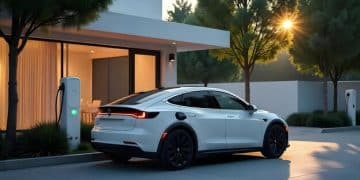Sustainable Transportation: EV, Hybrids, Public Transit Compared

Navigating sustainable transportation involves understanding the distinct benefits, limitations, and environmental impacts of electric vehicles (EVs), hybrid cars, and public transit options to make informed choices for a greener future.
In an era increasingly defined by environmental consciousness and the urgent need to mitigate climate change, the choices we make about how we move are more scrutinized than ever. The concept of sustainable transportation: comparing electric vehicles, hybrids, and public transit options, has moved from niche discussion to mainstream imperative. This article delves into the nuances of these primary sustainable mobility solutions, providing a comprehensive, research-backed comparison to equip you with the knowledge to navigate this evolving landscape.
The Evolving Landscape of Sustainable Transportation
The global push for sustainability has profoundly reshaped the automotive and urban planning sectors, driving innovation in how we commute and travel. Sustainable transportation is no longer a futuristic concept but a developing reality, encompassing various technologies and infrastructural shifts designed to reduce our carbon footprint. This movement is fueled by growing concerns over air quality, fossil fuel dependency, and urban congestion, creating a demand for cleaner, more efficient, and accessible modes of transport.
The transition toward sustainable mobility involves a complex interplay of technological advancements, policy incentives, and shifts in consumer behavior. Governments worldwide are implementing stricter emission standards and offering subsidies for greener vehicles, while cities are investing in robust public transit networks. This broad transformation aims to create transportation systems that meet present needs without compromising the ability of future generations to meet their own. It’s about designing mobility solutions that are not only environmentally sound but also economically viable and socially equitable.
Technological Innovation Driving Change
The bedrock of sustainable transportation lies in continuous technological innovation. From advanced battery technologies for electric vehicles to intelligent traffic management systems for public transit, research and development are propelling the sector forward. These innovations aim to enhance efficiency, reduce energy consumption, and minimize the environmental impact of transport operations.
- Battery Advancements: Increased range and faster charging for EVs.
- Smart Grid Integration: Optimizing EV charging with renewable energy sources.
- Autonomous Driving: Potential to improve traffic flow and reduce accidents.
- High-Speed Rail: Offering energy-efficient intercity travel.
Policy and Infrastructure Development
Alongside technological progress, supportive policies and robust infrastructure are crucial. Governments are introducing carbon pricing, promoting urban densification to reduce travel distances, and investing heavily in public charging stations and dedicated bus lanes. These initiatives create an environment where sustainable options become more convenient and cost-effective than traditional fossil-fuel alternatives. The development of charging infrastructure, for instance, directly impacts the feasibility and widespread adoption of electric vehicles, addressing a primary concern for potential buyers.
The shift towards sustainable transportation is multifaceted, reflecting a collective commitment to protecting our planet. It requires a holistic approach, integrating various solutions to build a resilient and environmental-friendly transport ecosystem for the future. Understanding the different facets of this transformation helps appreciate the complexities and opportunities within this critical global endeavor.
Electric Vehicles (EVs): The Charge Towards Zero Emissions
Electric Vehicles (EVs) represent a significant leap forward in the quest for sustainable transportation, primarily due to their zero tailpipe emissions. Unlike traditional gasoline-powered cars, EVs run solely on electricity, eliminating direct contributions to air pollution and greenhouse gas emissions during operation. This fundamental difference makes them a cornerstone of future mobility, offering a potent solution to urban air quality issues and climate change mitigation efforts.
The rapid advancements in battery technology, alongside decreasing manufacturing costs, have made EVs increasingly competitive with conventional vehicles. Modern EVs boast impressive ranges, rapid acceleration, and a surprisingly quiet driving experience, challenging preconceived notions about their practicality. As charging infrastructure continues to expand globally, the convenience factor of owning an EV improves, addressing one of the former major barriers to widespread adoption.
Types of Electric Vehicles
The term EV encompasses several categories, each with distinct characteristics regarding how they store and utilize electrical power. Understanding these variations helps clarify the diverse offerings within the EV market and their specific applications.
- Battery Electric Vehicles (BEVs): These are purely electric, running 100% on battery power with no internal combustion engine. They charge by plugging into an external power source.
- Plug-in Hybrid Electric Vehicles (PHEVs): PHEVs combine an electric motor and battery with a gasoline engine. They can operate purely on electricity for a limited range, then switch to gasoline or a hybrid mode. They can also be plugged in to charge their battery.
- Fuel Cell Electric Vehicles (FCEVs): Less common, FCEVs generate electricity using a fuel cell powered by hydrogen. Their only emission is water vapor, offering another zero-emission alternative, though hydrogen fueling infrastructure is still nascent.
Environmental and Economic Impact of EVs
While EVs produce zero tailpipe emissions, their overall environmental impact depends on the source of electricity used for charging. When charged with renewable energy (solar, wind), the lifecycle emissions of an EV are significantly lower than conventional gasoline cars. Even when charged with grid electricity from fossil fuels, studies often show EVs still outperform gasoline cars in terms of overall emissions due to the efficiency of electric motors.
Economically, EVs offer several advantages. Reduced fuel costs are a major draw, as electricity is typically cheaper per mile than gasoline. Maintenance costs can also be lower due to fewer moving parts compared to an internal combustion engine. Government incentives, such as tax credits and rebates, further sweeten the deal, making the initial purchase more accessible for consumers committed to sustainable living. These factors combine to make EVs a compelling solution for individuals aiming to reduce their environmental footprint and save money in the long run.
Hybrid Vehicles: Bridging the Gap
Hybrid vehicles offer a transitional solution in the journey toward fully sustainable transportation, blending the efficiency of electric motors with the familiarity of gasoline engines. They serve as a crucial bridge between conventional internal combustion engine cars and pure electric vehicles, appealing to drivers who seek improved fuel economy and reduced emissions without the full commitment to an all-electric lifestyle. Hybrid technology has evolved significantly, moving beyond simple gasoline-electric pairings to sophisticated systems that optimize power delivery and energy recovery.
The core advantage of a hybrid vehicle lies in its ability to automatically switch between electric power, gasoline power, or a combination of both, depending on driving conditions. This adaptability allows hybrids to achieve impressive fuel efficiency, especially in stop-and-go city traffic where electric propulsion can take over for short distances. This dual system provides the range and refueling convenience of a gasoline car while offering a taste of electric driving.
How Hybrid Technology Works
At its heart, a hybrid vehicle integrates an internal combustion engine (ICE), an electric motor, and a battery pack. The vehicle’s computer system intelligently manages these components to maximize efficiency. During braking, for instance, kinetic energy is captured and converted into electricity to recharge the battery—a process known as regenerative braking—reducing wear on brake pads and recovering energy that would otherwise be lost.
There are primarily two types of hybrid configurations that dictate how the engine and motor work together:
- Parallel Hybrids: Both the electric motor and the gasoline engine can directly power the wheels, either independently or together. This is the most common hybrid design.
- Series Hybrids: The gasoline engine acts as a generator to charge the battery, which then powers the electric motor that drives the wheels. The engine does not directly power the wheels.
Advantages and Limitations of Hybrids
Hybrids offer a compelling package of benefits. They typically achieve significantly better fuel economy than gasoline-only vehicles, translating to lower running costs and fewer trips to the gas station. Their reduced emissions, particularly in urban areas where electric mode is more frequently engaged, contribute positively to air quality. Furthermore, hybrids mitigate range anxiety, as drivers don’t have to worry about finding charging stations, given their gasoline engine backup.
However, hybrids also have limitations. While they are more eco-friendly than conventional cars, they still produce tailpipe emissions when the gasoline engine is in use, unlike pure EVs. Their complex powertrains can sometimes lead to higher maintenance costs compared to non-hybrid gasoline cars. Additionally, the federal tax credits and incentives often available for pure EVs or plug-in hybrids are sometimes less substantial for conventional hybrids, which can impact the overall cost of ownership. Despite these drawbacks, hybrids continue to play a vital role in reducing the automotive industry’s environmental impact, serving as an accessible step towards a more sustainable future.
Public Transit Options: The Collective Approach to Sustainability
Public transit represents perhaps the most impactful collective solution for sustainable transportation, offering a highly efficient way to move large numbers of people with a significantly reduced environmental footprint per individual. From urban bus networks and subway systems to regional trains, public transport infrastructure is a cornerstone of smart, sustainable urban planning. Its core principle is to reduce the personal vehicle dependency, thereby alleviating traffic congestion, minimizing parking demands, and collectively lowering emissions in densely populated areas.
The effectiveness of public transit is rooted in its capacity utilization. A single bus can replace dozens of cars, and a train can transport hundreds, dramatically reducing the collective carbon emissions and energy consumption required for personal journeys. Beyond environmental benefits, robust public transit systems foster social equity by providing affordable and accessible mobility for all segments of society, regardless of car ownership. It encourages community interaction and can stimulate local economies by concentrating foot traffic in commercial areas.
Diverse Modes: From Buses to High-Speed Rail
Public transit encompasses a wide array of modes, each suited to different urban and intercity needs. Each mode plays a specific role in a comprehensive transportation network, aiming to provide seamless connectivity.
- Buses: Highly flexible, capable of serving various routes and adapting to changing demand. Modern buses often incorporate hybrid-electric or fully electric powertrains for reduced emissions.
- Trains (Subways, Light Rail, Commuter Rail): Ideal for high-capacity corridors, offering rapid transit with dedicated rights-of-way, bypassing traffic. Electric trains are particularly environmentally friendly.
- Ferries: For cities with extensive waterways, ferries provide an efficient and scenic mode of transport, often connecting areas inaccessible by other means.
- High-Speed Rail: Connecting major cities over long distances, high-speed rail offers a fast, energy-efficient alternative to air travel for intercity journeys.
Environmental and Societal Benefits of Public Transit
The environmental advantages of robust public transit systems are undeniable. By consolidating passenger trips, they drastically cut per-capita fossil fuel consumption and greenhouse gas emissions. A single commute on public transport avoids the emissions of a private vehicle, leading to cleaner air and healthier urban environments. Furthermore, less reliance on personal cars translates to less spent on road construction and maintenance, freeing up public funds for other critical services.
Societally, public transit plays a crucial role in enhancing quality of life. It reduces traffic congestion, leading to less time wasted in gridlock and fostering more predictable travel times. It also addresses parking shortages and reduces the need for extensive parking infrastructure, allowing land to be used for green spaces or housing. Moreover, effective public transport can facilitate access to employment, education, and healthcare for individuals who may not own a car, promoting economic inclusion and social mobility. The collective nature of public transit makes it a powerful tool for achieving broad sustainability goals and building more livable, equitable cities.
Comparative Analysis: EVs vs. Hybrids vs. Public Transit
Understanding the distinct roles of Electric Vehicles (EVs), Hybrid Vehicles, and Public Transit in
the sustainable transportation ecosystem requires a nuanced comparative analysis. Each option presents
a unique set of advantages and challenges, and the optimal choice often depends on individual
circumstances, geographical context, and specific sustainability goals. A comprehensive view reveals
that these modes are not always in direct competition but can often complement each other within a broader,
integrated mobility strategy.
The shift towards sustainable transportation isn’t about finding a single solution but about recognizing
the strengths of various options and deploying them strategically. For instance, while EVs excel in reducing
urban air pollution and individual carbon footprints for daily commutes, public transit offers unparalleled
efficiency for mass movement in dense urban centers. Hybrids, meanwhile, provide a practical stepping stone
for those not yet ready for a full EV commitment, offering better fuel economy and reduced emissions than
conventional vehicles without range anxiety.
Performance and Efficiency Metrics
When evaluating performance, EVs typically lead in terms of energy efficiency from the grid to the wheel,
converting a high percentage of electricity into motion. They offer instant torque, leading to quick
acceleration and a quiet ride. Hybrids improve upon conventional gasoline cars by optimizing fuel
consumption through electric assistance and regenerative braking, particularly in stop-and-go traffic.
Public transit, when assessed on a per-passenger-mile basis, is often the most energy-efficient due to
its high occupancy rates, maximizing fuel efficiency through collective transport.
Long-term cost comparison also reveals varied benefits:
- EVs: Lower “fuel” costs (electricity cheaper than gasoline), reduced maintenance costs due to fewer moving parts, potential for government incentives. Higher initial purchase price.
- Hybrids: Better fuel economy than conventional cars, leading to fuel savings. Generally lower initial cost than EVs. Similar maintenance to conventional cars, with added hybrid componentry.
- Public Transit: Dramatically lower personal cost of ownership (no fuel, maintenance, insurance, or parking fees). Monthly passes often cheaper than owning and operating a car.
Environmental Impact and Accessibility
The environmental impact of each mode varies significantly. EVs have zero tailpipe emissions,
contributing to cleaner urban air, though their overall carbon footprint depends on the electricity source.
Hybrids offer reduced emissions compared to gasoline cars but still produce tailpipe emissions when
their internal combustion engine is active. Public transit delivers the largest per-capita emissions reduction
by taking multiple cars off the road, and its environmental benefits are magnified when powered by renewable
energy or through efficient electric train systems.
Considering accessibility, public transit excels in providing mobility to those without private vehicles,
supporting social equity and broader access to opportunities. EVs and hybrids, while still private means of
transport, require a financial investment and access to charging infrastructure (especially for EVs). However,
they offer personal flexibility and convenience that public transit may not always provide for door-to-door
travel or rural settings. The choice among these options often boils down to balancing individual convenience,
cost, and environmental impact against the collective benefits of shared mobility.
Challenges and Innovations in Sustainable Mobility
The transition to a fully sustainable transportation system is not without its significant challenges,
ranging from technological hurdles and infrastructural demands to economic viability and consumer
behavior shifts. Despite the remarkable progress in electric vehicle technology and the expansion
of public transit networks, several barriers must be overcome to fully realize the promise of a
green mobility future. Addressing these challenges requires concerted efforts from governments,
industries, and communities, alongside continuous innovation.
One of the primary challenges for Electric Vehicles (EVs) is the charging infrastructure. While growing,
the availability and speed of charging stations, particularly in remote areas or apartment complexes,
remain a concern for many prospective buyers. The cost of batteries, though decreasing, still contributes
to higher upfront purchase prices for some EV models. For public transit, increasing ridership and
funding for expansion and modernization are constant struggles, often hampered by political will and
complex planning processes.
Battery Technology and Charging Infrastructure
Innovations in battery technology are crucial for overcoming the limitations of current EVs. Researchers are
focused on developing batteries with higher energy density, faster charging capabilities, longer lifespans,
and lower costs. Advancements in solid-state batteries, for instance, promise to address several of these issues,
potentially revolutionizing EV performance and accessibility. Simultaneously, the deployment of robust and
ubiquitous charging infrastructure—from fast chargers along highways to residential and workplace charging
solutions—is essential for mass EV adoption.
Sustainable Fuel Alternatives and Vehicle Design
Beyond electricity, the transport sector is exploring other sustainable fuel alternatives and innovative
vehicle designs. Hydrogen fuel cells, while still niche, offer a zero-emission option for certain applications,
particularly heavy-duty transport. Research into synthetic fuels and biofuels aims to decarbonize existing
fleets. Furthermore, vehicle design itself is evolving, with efforts to lightweight materials, improve
aerodynamics, and integrate renewable energy sources (like solar panels on vehicles) to enhance efficiency
and reduce environmental impact. These innovations aim to make transportation cleaner, even for modes
that may not be fully electric.
Smart Cities and Integrated Mobility Solutions
The concept of smart cities plays a pivotal role in integrating sustainable mobility solutions. This involves
the use of technology to optimize traffic flow, enhance public transit efficiency, and facilitate multimodal
journeys. Digital platforms that combine real-time public transit information, ride-sharing options, and
EV charging station availability can help users make informed, sustainable travel choices. Integrating
bike-sharing programs, pedestrian-friendly infrastructure, and demand-responsive transport further
enhances urban mobility, making cities more livable and less dependent on private car ownership. These
holistic approaches are key to creating truly sustainable and resilient transportation ecosystems.
The Future of Sustainable Transportation: An Integrated Vision
The trajectory of sustainable transportation points towards an integrated and multimodal future, where
Electric Vehicles (EVs), Hybrid Vehicles, and robust Public Transit systems don’t operate in isolation but
form a cohesive network. This vision aims to maximize efficiency, minimize environmental impact, and enhance
accessibility for all. The evolving landscape suggests a move away from sole reliance on personal vehicles
towards a diversified approach that leverages the strengths of each transport mode to create a more resilient
and environmentally friendly mobility ecosystem.
This integrated vision is propelled by advancements in digital technologies, which enable seamless
connectivity and real-time information sharing across different transport options. Imagine a scenario where
your journey begins with a walk or bike ride to a public transit hub, followed by an efficient train journey,
and concludes with an electric vehicle ride-share or taxi for the “last mile.” This multi-layered approach
reduces reliance on single-occupancy vehicles, optimizes energy consumption, and significantly lowers
collective emissions.
Policy Frameworks and Urban Planning
Realizing this integrated future requires progressive policy frameworks and strategic urban planning.
Governments are increasingly focusing on policies that prioritize public transit infrastructure development,
incentivize EV adoption, and promote walkable/bikable communities. Urban planning is shifting towards
creating mixed-use developments that reduce the need for long commutes and integrate transport hubs
seamlessly into city life. Smart growth principles, which advocate for compact, transit-oriented development,
are central to this evolution.
The emphasis is on creating cities where:
- Connectivity is Key: Seamless transfers between different modes of transport.
- Infrastructure Supports Diversity: Dedicated lanes for buses, extensive bike paths, accessible charging points.
- Technology Empowers Users: Real-time information and integrated payment systems for all transport options.
Emerging Technologies and Behavioral Shifts
The future of sustainable transportation will also be shaped by emerging technologies such as autonomous
vehicles and vehicle-to-grid (V2G) technology. Autonomous shared EVs could revolutionize urban mobility,
offering on-demand transportation that is both efficient and environmentally friendly. V2G technology would
allow EVs to return excess energy to the grid, stabilizing renewable energy supplies and turning vehicles
into mobile power storage units. These technological innovations, coupled with a fundamental shift in
consumer behavior towards shared, active, and public transport, are crucial for a low-carbon future.
Ultimately, the future of sustainable transportation is a collaborative effort involving policymakers,
innovators, businesses, and individuals. By embracing a holistic, integrated approach that combines the
best aspects of electric vehicles, hybrids, and public transit, we can pave the way for greener, more
efficient, and more equitable mobility systems that benefit both people and the planet. This integrated
vision moves beyond simple comparisons to build a comprehensive framework for sustainable movement.
| Key Aspect | Brief Description |
|---|---|
| ⚡ EV Advantage | Zero tailpipe emissions, high energy efficiency, lower running costs. |
| 🔄 Hybrid Balance | Improved fuel economy over gasoline cars, reduced emissions, no range anxiety. |
| 🚇 Public Transit Impact | Significant per-capita emissions reduction, congestion relief, social equity. |
| 🔗 Integrated Future | Combines all modes for optimal efficiency, environmental benefits, and accessibility. |
Frequently Asked Questions About Sustainable Transportation
Generally, public transit, especially electric trains or well-utilized buses, is considered the most environmentally friendly option per person due to high occupancy and efficient use of resources. For personal travel, electric vehicles (EVs) powered by renewable energy sources offer the lowest carbon footprint as they produce zero tailpipe emissions.
Yes, hybrid vehicles are a solid choice for daily commuting, particularly in urban areas with stop-and-go traffic. They offer improved fuel efficiency and lower emissions compared to conventional gasoline cars, effectively bridging the gap between traditional vehicles and pure electric models while eliminating range anxiety often associated with EVs.
Public transit offers numerous benefits, including reduced traffic congestion, enhanced air quality through fewer individual vehicle emissions, and significant cost savings for commuters by eliminating fuel, parking, and maintenance expenses. It also promotes social equity by providing accessible transportation regardless of car ownership, and contributes to more livable cities.
EV charging requires electricity from the grid. While a mass transition to EVs will increase electricity demand, smart charging systems and the integration of renewable energy sources are being developed to manage this. Innovations like vehicle-to-grid (V2G) technology can even allow EVs to support the grid by returning power during peak demand periods, enhancing grid stability.
Personal choices are crucial in shaping sustainable transportation. Opting for public transit, cycling, walking, or choosing an EV or hybrid over a conventional car directly reduces individual carbon footprints. Supporting policies that foster green infrastructure and demanding more sustainable options from manufacturers and urban planners also contribute significantly to the collective effort.
Conclusion
The exploration of sustainable transportation, encompassing electric vehicles, hybrids, and public transit, reveals a dynamic and multifaceted landscape. Each option presents distinct advantages and plays a vital role in our collective journey toward a more sustainable future. While EVs lead the charge with zero tailpipe emissions and rapidly advancing technology, hybrids provide a pragmatic transition, offering improved efficiency without the full commitment to electric infrastructure. Public transit, with its inherent capacity for mass movement, stands as a cornerstone of urban sustainability, offering unparalleled collective benefits in terms of emissions reduction and congestion relief. The path forward is likely not one of exclusive choices but one of integrated strategies, where these various modes complement each other, supported by innovative policies and a growing awareness of our environmental responsibilities. Ultimately, fostering sustainable transportation is a shared endeavor, requiring both individual choices and systemic changes to achieve truly greener and more equitable mobility for all.





